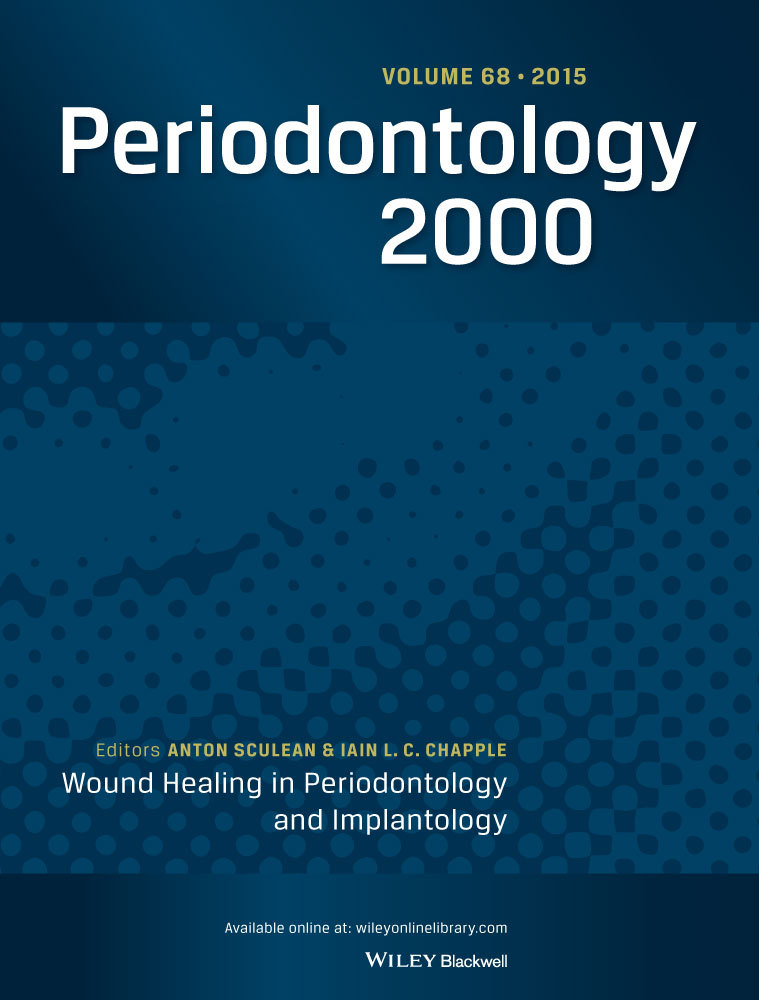The oral microbiota and periodontal health in orthodontic patients
IF 15.7
1区 医学
Q1 DENTISTRY, ORAL SURGERY & MEDICINE
引用次数: 0
Abstract
The oral microbiota develops within the first 2 years of childhood and becomes distinct from the parents by 4 years‐of‐age. The oral microbiota plays an important role in the overall health/symbiosis of the individual. Deviations from the state of symbiosis leads to dysbiosis and an increased risk of pathogenicity. Deviations can occur not only from daily life activities but also from orthodontic interventions. Orthodontic appliances are formed from a variety of biomaterials. Once inserted, they serve as a breeding ground for microbial attachment, not only from new surface areas and crevices but also from material physicochemical interactions different than in the symbiotic state. Individuals undergoing orthodontic treatment show, compared with untreated people, qualitative and quantitative differences in activity within the oral microbiota, induced by increased retention of supra‐ and subgingival microbial plaque throughout the treatment period. These changes are at the root of the main undesirable effects, such as gingivitis, white spot lesions (WSL), and more severe caries lesions. Notably, the oral microbiota profile in the first weeks of orthodontic intervention might be a valuable indicator to predict and identify higher‐risk individuals with respect to periodontal health and caries risk within an otherwise healthy population. Antimicrobial coatings have been used to dissuade microbes from adhering to the biomaterial; however, they disrupt the host microbiota, and several bacterial strains have become resistant. Smart biomaterials that can reduce the antimicrobial load preventing microbial adhesion to orthodontic appliances have shown promising results, but their complexity has kept many solutions from reaching the clinic. 3D printing technology provides opportunities for complex chemical syntheses to be performed uniformly, reducing the cost of producing smart biomaterials giving hope that they may reach the clinic in the near future. The purpose of this review is to emphasize the importance of the oral microbiota during orthodontic therapy and to use innovative technologies to better maintain its healthy balance during surgical procedures.正畸患者的口腔微生物群与牙周健康
口腔微生物群在儿童期的头 2 年中开始发育,到 4 岁时与父母的口腔微生物群截然不同。口腔微生物群对个人的整体健康/共生起着重要作用。偏离共生状态会导致菌群失调,增加致病风险。偏离不仅可能发生在日常生活活动中,也可能发生在正畸干预中。正畸装置由各种生物材料制成。一旦插入,它们就会成为微生物附着的温床,不仅来自新的表面区域和缝隙,还来自与共生状态不同的材料物理化学相互作用。接受正畸治疗的人与未接受治疗的人相比,在整个治疗期间,由于龈上牙龈和龈下牙龈微生物菌斑的滞留增加,口腔微生物群的活动在质和量上都出现了差异。这些变化是牙龈炎、白斑病(WSL)和更严重的龋病等主要不良反应的根源。值得注意的是,正畸干预最初几周的口腔微生物群谱可能是一个有价值的指标,可用于预测和识别其他健康人群中牙周健康和龋病风险较高的个体。抗菌涂层已被用来阻止微生物附着在生物材料上;然而,它们会破坏宿主微生物群,一些细菌菌株已产生抗药性。智能生物材料可以减少抗菌负荷,防止微生物附着在牙齿矫正器上,已显示出良好的效果,但由于其复杂性,许多解决方案无法应用于临床。三维打印技术为统一进行复杂的化学合成提供了机会,降低了生产智能生物材料的成本,使其有望在不久的将来进入临床。本综述旨在强调口腔微生物群在正畸治疗过程中的重要性,并利用创新技术在手术过程中更好地维持其健康平衡。
本文章由计算机程序翻译,如有差异,请以英文原文为准。
求助全文
约1分钟内获得全文
求助全文
来源期刊

Periodontology 2000
医学-牙科与口腔外科
CiteScore
34.10
自引率
2.20%
发文量
62
审稿时长
>12 weeks
期刊介绍:
Periodontology 2000 is a series of monographs designed for periodontists and general practitioners interested in periodontics. The editorial board selects significant topics and distinguished scientists and clinicians for each monograph. Serving as a valuable supplement to existing periodontal journals, three monographs are published annually, contributing specialized insights to the field.
 求助内容:
求助内容: 应助结果提醒方式:
应助结果提醒方式:


